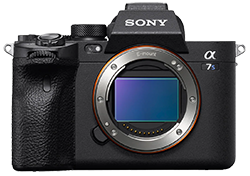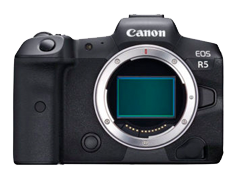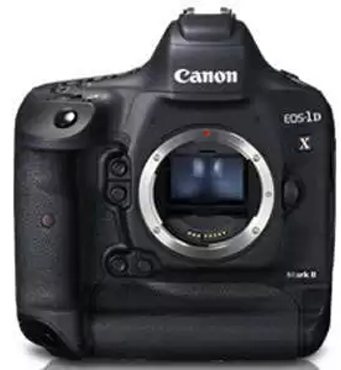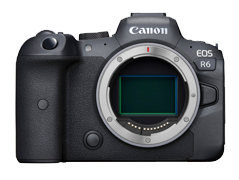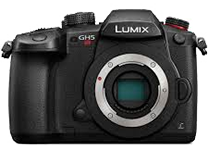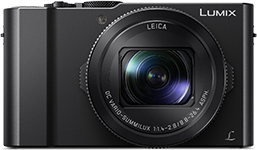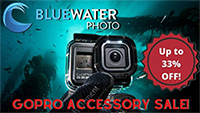
Features to Look For in an Underwater Video Camera:
What makes the “Best Underwater Video Camera”? When shooting underwater video, or video in general, there are many factors to consider. To start, being able to record 4K video is now a standard that is expected out of any respectable video camera. The good news is nearly every new DSLR, mirrorless or compact camera features 4K recording capabilities. You may even want to consider a video camera that can record 6K or 8K. When you film in very high resolutions like 8K, you are able to crop your video substantially in post processing, providing you with additional "broll" perspectives.
But as with photography, there's more to video than just resolution. You also want to consider the size of your sensor and how your camera processes the data from your sensor. As with photography, larger sensor sizes, like a super35 sensor, allow you to capture more light resulting in better dynamic range and quality in low light. However, APS-C, micro four thirds, and even 1" sensors produce very respectable video. Generally, a video oriented camera will actually have a slightly lower resolution than you might find in a photo camera. This is to keep every pixel on the sensor larger and collecting as much light as possible. The Sony A7S III performs very well in low light because its sensor is "only" 12 megapixels. A higher resolution sensor also requires more processing. The most ideal camera sensor is one that has a full pixel readout from a 35mm sensor (often shooting the initial video in 6K) that will downsample to 4K, adding additional details to the video. A sensor that has a one-to-one pixel readout (like the 12 MP Sony A7S III) will not downsample, but it will perform very well in low light as we mentioned before. Other cameras, especially high resolution cameras, may use pixel binning or line skipping to process the data from their sensor - resulting in slightly lower quality video.The worst video quality comes from cameras that “crop” the video by using only part of the sensor to capture footage.
The next most immediate specification to consider would be the frame rate that your video camera allows you to record in. Top-of-the-line video cameras record at 4K resolution and 60 frames per second (fps) or even 120 fps. High frame rates are absolutely essential for good underwater video. This is because three dimensional underwater environments produce a lot more camera shake in a scene than topside video. Unless you have a tripod, you need to capture your video at higher frame rates and slow it down in post processing to get stable footage. We recommend that serious underwater video shooters consier frame frates as being the most important specification in their chosen camera.
Finally, you will want to consider the codecs, bit rates, bit depth, color sampling, and picture profiles that your video camera can record in. Codecs are algorithms that compress your video data into a certain file type. The bit rate of your video is the amount of data that gets recorded from your system over a given time period. Some cameras can record at higher bit rates onto internal memory and some require external recorders to film at higher bit rates. Bit depth is the number of color options your camera can record with. With modern cameras, if you want to color grade in post processing, you should aim to record at 10-bits or higher. Color sampling refers to how accurate the color capture on your camera is by the number of pixels it chooses to determine the color in a square area of your image. If you are color grading than you will want a camera that can record 4:2:2. If you are not color grading then 4:2:0 is acceptable. Finally,picture profiles are algorithms that "bake-in" data into your video file resulting in a certain "look" to your video. Log profiles can be particularly useful for color grading because they save details from the highlighs and shadows of your image - much like a "poor mans" RAW file. If you post-process heavily, then you will can to consider a camera that can record RAW filetypes including ProRes RAW and Blackmagic RAW. These are uncompressed formats that maximize the information gathered by the sensor and provide you with extended flexibility when it comes to color grading and post-processing.
It is important to note that many cameras record at higher bit rates, deeper bit depths, and sometimes with RAW or Log file types with an external recorder, like the Atomos Ninja V external recorder. Nauticam offers a housing for the Ninja V for use with your underwater system.
Other factors to consider when choosing an underwater video camera are in-body image-stabilization (IBIS), autofocus capability, low light sensitivity, lens options, and, well, of course, the price tag.
If you're looking to step up your game and ensure reproducing the colors and beauty of the underwater world, make sure to also choose the right underwater camera light.
Here we will walk you through some of the key points that make each camera great for underwater video and hopefully make the process of choosing which underwater video camera is best for you, a little bit easier. Of course, our extremely knowledgeable sales staff is always here to help you make your decision - feel free to contact us at sales@bluewaterphotostore.com.
Best Underwater Video Camera - Sony A7S III
Read our Full Review for the Sony A7S III Camera
The Sony A7S III is a spectacular video-oriented full frame mirrorless camera that is shaping up to be 2022's best camera for underwater video. The A7S III is our favorite underwater video camera because of the wide range of options available from frame rates to bit rates and codecs to picture profiles. It can record 4K video up to 120fps for slow motion and stable video, with 10-bit 4:2:2 internal recording for the best color science Sony has to offer when paired with a wide variety of Log profiles. It is also an excellent stills camera with 12 megapixels of resolution - enough for social media and most day-to-day useage - but likely not enough for working photographers that shoot macro or print large prints. Sony didn't holdback when it came to autofocus options, equipping the camera with Sony's excellent AF tracking and animal eye AF capability. True to form, the A7S III succeeds the A7S II as a lowlight masterpiece, it's ability bolstered by a lower resolution sensor and close to "dual gain" ISO. The A7S III does not have recording time limits and did not overheat in our underwater tests, despite some topside users complaining about overheating in direct sunlight. But what makes the Sony A7S III really shine for underwater video is its incredible low light video quality. We were able to film way past ISO 12,800 and still capture useable footage! In fact 12,800 looked as clean as we might expect from 640. Our video below says it all... enjoy.
Key Features:
- 12 MP BSI CMOS Full Frame Sensor
- Bioz XR Image Processor
- ISO 80-102,400
- "Low Base" and "High Base" (effectively dual gain) ISO capability for better low light shooting
- 4K video up to 120 fps
- No recording time limits. Could be limited by heat (4K @ 60p for at least an hour)
- 10-bit 4:2:2 internal recording
- S-LOG, HLG, Cine logarithmic picture profiles available
- 4K @ 60p, 16-bit RAW recording with an external recorder
- 5 axis in-body image-stabilization (IBIS)
- Dual card slots (either SD or CFexpress Type A)
- 9.44 M dot Electronic Viewfinder (EVF) - the best resolution on the market!
- Movie File Formats: XAVC S (Long GOP, H.264 MP4); XAVC HS (Long GOP, H.265 HEVC); XAVC S-1 (All-Intra, H.264 MP4)
- AF tracking with human and animal eye AF capability
- 759 point hybrid AF system with 425 contrast detection points
Underwater Housing Options:
- Ikelite Sony A7S III 200DL Underwater Housing - Compact, Lightweight & Affordable ($1,695.00)
- Nauticam Sony A7S III Underwater Housing - Excellent Ergonomics & Durable ($3,189.00)
- Isotta Sony A7S III Underwater Housing - Stylish & Robust ($2,690.00)
- Sea & Sea Sony A7S III Underwater Housing
Camera Body & Lenses:
- Sony A7S III Camera - $3,499.99
- Lens Options
Sample Underwater Video:
Best 8K Video Camera - Canon EOS R5
Read our Full Review of the Canon EOS R5
The Canon EOS R5 is the best 8K video camera on the market. Moreover, we think the R5 has the best underwater stabilization of any camera - making it a top camera for handheld video shooters. A wide range of new technology introduced in this system makes it optimal for underwater creatives ranging from a 45 megapixel full-frame sensor that captures clean, beautiful images to 8K/30p and 4K/120 internal RAW 10-bit 4:2:2 video recording capability. The in-body image-stabilization system built into the camera is second to none with the ability to recover up to 8 stops of exposure. This means you can shoot handheld video with a 100mm macro tha looks almost as if it's on a tripod (check out our sample underwater video below). Moreover, the autofocus system in the R5 is one of the best on the market and is as good as Sony's or better. We were very impressed that the R5 was able to track fish eyes underwater in many situations - especially when shooting macro photos and video. We are very excited to see where animal eye autofocus technology will go in the future. The video this camera can capture is truly wonderful. 8K/30p video is useful for underwater video shooters that want to crop in their video footage. It is very helpful to macro video shooters especially. When you combine 4K/120p video with the R5's IBIS system, there is no other way to get more stable handheld video footage. Did we mention the R5 can record RAW video internally?? It's a video editors dream.
Key Features:
- New 45 Megapixel Full-Frame CMOS Sensor and Digic X processor
- Canon's first 5 axis In-Body Image-Stabilization (IBIS) which works in conjunction with optical IS RF and EF lenses. Up to 8 stops of correction
- Improved Dual Pixel II Autofocus
- 5,940 AF points
- 100% of the sensor has AF coverage!
- ISO 100 - 51,200
- Animal eye AF detection (for birds, cats, and dogs) - it works on macro fish 20-40% of the time!
- 12fps burst shooting with mechanical shutter
- 20 fps burst shooting with silent (electronic shutter)
- 180 shot RAW image buffer
- Dual card slots - 1x CFexpress and 1x SD UHS-II
- 8K video @ 30p, 10- bit 4:2:2 - using the full width of the sensor!
- Internal RAW and C-Log recording
- 4K oversampled video up to 120p, 10-bit 4:2:2
Underwater Housing Options:
- Aquatica Canon EOS R5 Underwater Housing - Rugged & Compact ($2,879.10)
- Nauticam Canon EOS R5 Underwater Housing - Excellent Ergonomics & Durable ($3,965.00)
- Ikelite Canon EOS R5 200DL Underwater Housing - Affordable & Great TTL Option ($1,695.00)
- Sea & Sea Canon EOS R5 Underwater Housing
- Isotta Canon EOS R5 Underwater Housing
Sample Underwater Image:
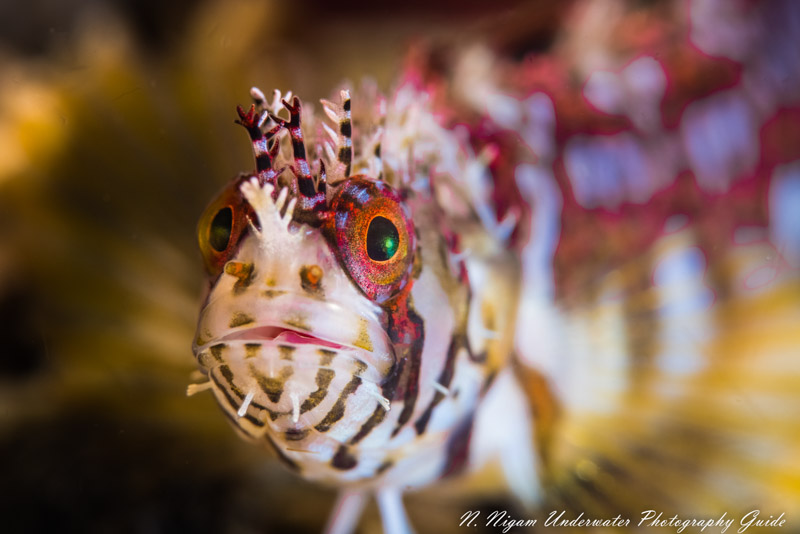
Spectacular resolution with the Canon EOS R5. Photo of a mosshead warbonnet captured with the Canon EOS R5 in an Ikelite housing, Canon 100 mm macro lens, dual Ikelite DS 161 strobes, Kraken +13 diopter, and Ikelite Canon TTL converter. f/16, 1/160, ISO 100
Best for Post Production - Blackmagic Pocket Cinema Camera 4K & 6K Camera

The Blackmagic Pocket Cinema Camera 4K & Blackmagic Pocket Cinema Camera 6K are small & compact video cameras that pack a serious punch! Both cameras have a sleek design and high-end video camera features at an affordablle price. The Blackmagic Pocket Cinema Camera 4K utilizes micro four thirds mount while the Blackmagic Pocket Cinema Camera 6k utilizes full frame EF Mount which makes it better for bokeh shots. Blackmagic RAW gives any video editor using Davinci Resolve (which comes complimentary with the camera) the ultimate manipulative experience. You can even set your ISO in post!
Pocket Cinema Camera 4K:
|
Pocket Cinema Camera 6K:
|
Blackmagic Cameras:
Underwater Housing Options:
- Nauticam Blackmagic Pocket Cinema Camera 4K Underwater Housing - $3,792.00
- Nauticam Blackmagic Pocket Cinema Camera 6K Housing - $4,826.00
Underwater Packages:
Best DSLR Camera for Video - Canon 1DX Mark III
Read our Full Review of the Canon 1DX Mark III
Underwater video is really where the Canon 1DX Mark III shines. As Canon's flagship DSLR camera, it's a serious contender for professional videographers who are in the market for high-end video cameras and even cinema cameras. With RAW recording capability combined with 5.5K @ 60 fps resolution, there are few cameras on the market as capable for taking detailed video that can be manipulated freely in post processing. True RAW recording is always going to be better than using Log profiles, like C-Log - which is also available with the camera. The footage can be captured using the full width of the sensor, which means maximum details, no crop, and downsampled 4K video is going to look pretty tasty. Overall, underwater videographers should be pleased to finally have a Canon camera that doesn't compromise. There are no crops, all the frame rates you could want are there, and there are very few caveats.
Key Features:
- 20.1 MP Full-Frame CMOS Sensor
- DIGIC X processor
- ISO Range - 100-102,400
- Burst shooting: 16fps viewfinder, 20 fps live view
- 191 (155 cross-type) AF points
- JPEG, HEIF, and RAW image formats
- Dual CFexpress card slots
- Video: 5.5K @ 60fps with RAW recording, 4K @ 60fps, 1080p @ 120 fps. Capable of 10-bit 4:2:2 recording with Canon Log profiles
- 3.2" 2.1 million dots LCD
- 1000+ RAW image buffer
Canon 1DX Mark III Underwater Housing Options:
- Nauticam Canon 1DX Mark III Underwater Housing - $5,861.00
Best Hydrid Camera for Video & Photo - Canon EOS R6
Read our Full Review of the Canon EOS R6 Camera
The Canon EOS R6 is Canon's newest prosumer level full-frame mirrorless camera released alongside the EOS R5. The only real difference from the R5 is a drop in resolution for both photo and video and a drop in retail price of $1400 - which is why we are naming it the "best value" camera this year. In fact, we think it's the perfect camera for anyone thinking about getting into video with a full-frame sensor. The R6 features a 20.1 megapixel full-frame CMOS sensor and is capable of 4K video at 60 fps using 94% of the sensor width. The R6 has been updated with new features like in-body image-stabilization, animal eye autofocus, 100% AF coverage, and 12 fps/20 fps electronic burst shooting. Due to these impressive specs, the R6 is a top camera for underwater photographers and videographers and a top focus for underwater housing manufacturers. It's a great camera with excellent image quality, fast autofocus, and compatability with both RF and EF lenses (when using an EF-R adapter). The video quality with the R6 is only a step below the R5 when it comes to frame rates and resolution. The Canon R6 cannot capture 8K video or 4K/120p video. However, it is capable of amzing 4K/60p video with excellent low light capability due to the reduced sensor resolution from the R5.
Key Features:
- 20.1 Megapixel Full-Frame CMOS Sensor and Digic X processor
- Canon's first 5 axis In-Body Image-Stabilization (IBIS) which works in conjunction with optical IS RF and EF lenses. Up to 8 stops of correction
- Improved Dual Pixel II Autofocus
- ISO 100-102400
- 100% of the sensor has AF coverage!
- Animal eye AF detection (for birds, cats, and dogs) - we'll see if it works for fish!
- 12fps burst shooting with mechanical shutter
- 20 fps burst shooting with silent (electronic shutter)
- Dual card slots - 2x SD UHS-II
- Internal C-Log recording
- 4K video up to 60 fps, 10-bit 4:2:2 (16:9, 1.07X crop)
- 3.69 million dot EVF
Underwater Housing Options:
- Ikelite Canon EOS R6 200DL Underwater Housing - Won't Break the Bank, Lightweight ($1,695.00)
- Nauticam Canon EOS R6 Underwater Housing - User Friendly & Built-to-Last ($3,965.00)
- Isotta Canon EOS R6 Underwater Housing
- Aquatica Canon EOS R6 Underwater Housing
Sample Underwater Image and Video:

This image shows the beautiful image quality and dynamic range that the R6 is capable of capturing. This anemone was photographed with the Canon EOS R6 and Canon 8-15mm fisheye lens in an Ikelite EOS R6 housing. The image was slightly underexposed and adjusted in post processing. This image shows the quality of the details recovered. f/13, 1/60, ISO 320
Best Panasonic Camera for Video - Panasonic S1H
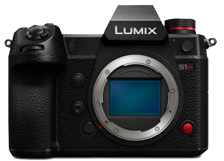
Read our Full Review of the Panasonic S1H
While Panasonic is known for producing excellent video cameras, it does appear that Panasonic is slipping in the video market. We listed the Pansonic S1H more to pay homage to the market dominance Panasonic once had. The S1H is still the top mirrorless video camera from Panasonic. It can capture 6K video which is great for crops as well as 4K/60p video. Any video shooter would be happy with this camera. But if you don't have a bunch of "L mount alliance" lenses, you may want to consider another camera on this list.
Key Features:
- 24.2 MP Full-Frame CMOS Sensor
- Venus Engine
- 5 Axis Sensor-Shift Image Stabilization
- Depth-From-Defocus Autofocus
- 4k & 6K Photo
- Optimized for Video Applications
- Dual Native ISO
- Simultaneous internal recording and external recording via HDMI
- Bluetooth & Wifi
- Weather sealed - splash, dust, and freezeproof
- 5.76m-dot OLED Electronic Viewfinder
- 3.2" 2.33m-dot touchscreen LCD
- Dual SD Card Slot
Key Features:
- Nauticam Panasonic S1H Underwater Housing - $3,965.00
Best Nikon Camera for Video - Nikon Z7 II
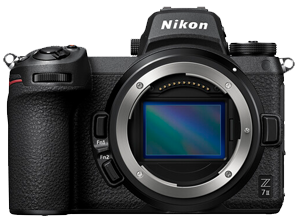
Read our Full Nikon Z6 II, Z7 II Camera Review
Yes, we created a special category for Nikon. The reason for this is because Nikon cameras have been lagging behind Canon and Sony cameras in technological innovation over the past three years. Therefor, it was difficult to place any new cameras from Nikon on this list. However, there are a lot of avid Nikon DSLR shooters out there, and we think it's time for Nikon underwater shooters to make the switch to mirrorless - especially when it comes to video. The Nikon Z7II and Z6II are the two top video cameras from Nikon. They are the first to offer 4K/60p recordering, which is great for underwater shooters who need to stabilize their video. As you can see we really took advantage of the improved frame rates in the video below. The Z6II and Z7II are not the best cameras for post processing. Internally, they can only record 8-bit 4:2:0 and have no Log options. However, this changes if you add an Atomos Ninja V monitor. So if you're a serious Nikon video shooter, you may want to consider the Atomos Ninja V as well.
Key Features:
- 45.7 megapixel full-frame BSI CMOS sensor (no lowpass filter)
- ISO 64 - 25,600
- 5 axis in-body image-stabilization (IBIS)
- dual Expeed 6 processors
- 3.6 million dot EVF
- 1/200s flash sync speed
- Dual XQD and UHS-II (SD) card slots
- 10 fps burst shooting
- 77 image buffer @ 12-bit lossless RAW files
- 493 point phase detect hybrid autofocus system
- -3 EV low light AF sensitivity
- 4K video recording up to 60 fps
- 10 bit 4:2:2 recording with N-Log over HDMI output
- 360 shot battery life
- Weight: 615 grams
- Size: 5.3 X 4 X 2.8 inches
Underwater Housing Options:
- Isotta Nikon Z6, Z7, Z 6II, Z 7II Underwater Housing - Innovative Design, High Quality Aluminum Housing ($2,690.00)
- Ikelite Nikon Z6, Z7, Z 6II, Z 7II Underwater Housing - Well Built, Affordable, Lightweight ($1,695.00)
- Aquatica Nikon Z6 II, Z7 II Underwater Housing
- Sea & Sea Nikon Z6 II, Z7 II Underwater Housing
- Nauticam Nikon Z6 II, Z7 II Underwater Housing - User Friendly Controls & Robust ($3,965.00)
Sample Underwater Image:
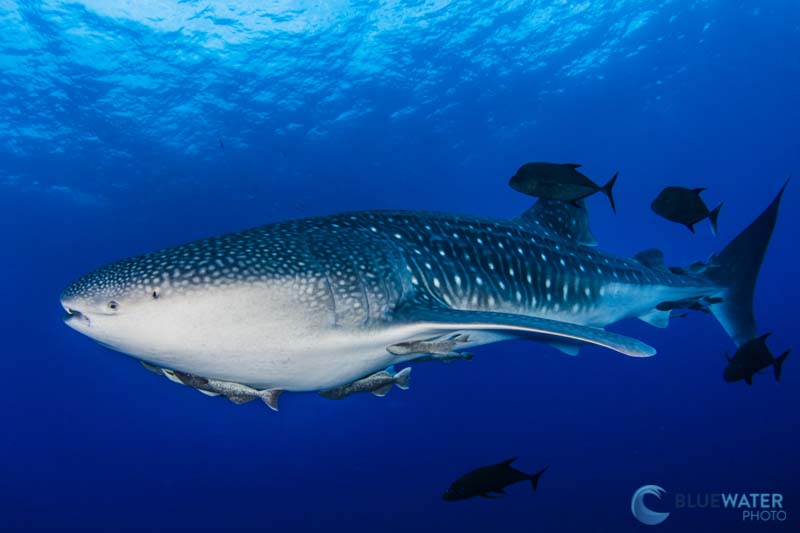
Whale shark photographed with the Nikon Z7II and the Nikon 8-15mm wide angle lens. 1/125, f/13, ISO 640
Best APS-C Video Camera - Sony A6600 & A6400
The Sony A6600 and A6400 are Sony’s top-of-the-line cropped sensor mirrorless cameras. They feature a 24MP APS-C CMOS sensor and records UHD 4K up to 30fps. The Sony A6600 offers many of the same pro-level features characteristic of Sony’s a7 series cameras, such as 5-axis image stabilization and S-Log picture profiles. The Sony A6400 offers the capability of shooting with hybrid log gamma, and an improved color science from its predecessors
Despite having a cropped sensor the A6600 and A6400 boat a highly reliable focusing system made up of 425 phase detection points. Not only that but they are two of the lightest and most compact cameras on the list despite having a fairly competitive sensor pixel count. If you are an aspiring or professional video shooter, the Sony A6500 and A6400 prove to be a great option for underwater video.
The 4K video details with both cameras are amazing because they have a full pixel readout, meaning they capture video in 6K and downsample to 4K, adding additional details.
For video, the biggest differences between the Sony A6400 and Sony A6600 are that the A6500 has in-body image-stabilization (IBIS). This is essential for getting nice, stable video, but the A6400 has had improvements has well including hybrid log gamma and an improved color science.
Key Features:
Sony A6600 Camera:
|
Sony A6400 Camera:
|
Sony A6400 Underwater Housings & Packages:
- Ikelite Sony A6400 Underwater Housing
- Nauticam NA-A6400 Underwater Housing
- Fantasea A6400 Underwater Housing
- Fantasea Sony A6400 Start-Up Package
- Fantasea Sony A6400 Housing, Port and Lens Gears Package
- Ultimate Fantasea A6400 Package
- Ikelite Sony A6400 Video Package
- Ikelite Sony A6400 Camera, Housing, Lens, Port, Gear Package
Sony A6600 Underwater Housings & Packages:
Best Micro Four Thirds Video Camera - Panasonic GH5S
Read our Review for the Panasonic GH5 Camera
After all this time the Panasonic GH5s still makes the list! Panasonic released the GH5s in early 2018 as an upgraded, video-centric version of the GH5. For the Lumix GH5s, Panasonic opted to ditch the 20.3MP Micro Four Thirds sensor that the Lumix GH5 uses, replacing it with a 10.2MP multi-aspect sensor. This makes it possible to shoot in 4K DCI (17:9), UltraHD (16:9), and Anamorphic 4:3 aspect ratios.
While the GH5 was the first mirrorless camera to record 4K 60p, the GH5s takes it one step further and can record 4k 60p in Cinema 4K (4096 x 2160) -- a version of 4K recording that maximized resolution. The GH5s is also capable of internal 4:2:2 10-bit recording, which delivers even stronger than the color reproduction. It can also shoot HD at 240fps, and you can use a Vlog-L color profile for great dynamic range.
The Panasonic Lumix GH5s has been the go-to mirrorless camera for video use over the last two years and even with the advent of newer full frame mirrorless cameras (as listed above) the GH5s still holds its own as a professional video system. There are various underwater housings available for the GH5s and with Nauticam’s newest version of the NA-GH5 you have the option of including an M28 bulkhead for use with HDMI 2.0 and the Atomos Ninja V recorder.
The GH5s is popular for underwater video because the camera is at a great price point, the body is relatively small, there is a multitude of micro-four thirds lenses available for any lens requirements, the video bitrate is quite high, and camera supports many video features that other micro-four thirds cameras do not support. It crushes all other micro-four thirds cameras at high ISOs with respect to noise.
The downside to the GH5s? Besides being only 10 megapixesl for stills, it does not have image stabilization as the GH5 does.
Key Features:
- 20MP Four Thirds sensor with no low pass filter
- 5-axis in-body image stabilization system with Dual IS 2 support
- 225-area Advanced Depth-From-Defocus AF system
- 4K and 6K Photo
- 9 fps shooting with continuous autofocus
- 4K footage taken using full width of the sensor
Underwater Housings Options:
- Nauticam GH5, GH5S, GH5II Underwater Housing
- Ikelite GH5, GH5S Underwater Housing
- Aquatica GH5 Underwater Housing
- Isotta GH5 Underwater Housing
Best Compact Video Camera - Panasonic Lumix LX10
The Panasonic Lumix LX10 is arguably the best compact, point and shoot camera for underwater video on the market. It uses a whopping 20MP sensor and shoots beautiful 4K video that you could expect from a high-end mirrorless camera. The footage is sharp and detailed due to the high megapixel count for such a compact camera. The f-stop ranges offered by the built in 24-72mm (35mm equivalent) lens allow for beautiful bokeh as well.
Panasonic is well established brand in the video realm and their reputation definitely precedes this product. They included a fast working DFD feature that calculated the focus distance to help prevent your video from being blurry or out of focus. If you want a simple, compact camera that will render high-quality underwater video, the Panasonic Lumix LX10 is a great camera for you.
Key Features:
- 10.2MP high-sensitivity MOS sensor with multi-aspect
- Dual native ISO with a range from 160 – 51,200 and extendable to 80 – 204,800.
- 4K DCI or UHD video recording, up to 60p
- V-Log L Gamma and HDR Hybrid Log Gamma
- Impressive low-light performance
- High speed focusing and 14-bit RAW Burst
- Slow Motion Video - C4K/4K (60-fps maximum 2.5x slower*) or Full HD (240-fps maximum 10x slower)
- 225-area Advanced Depth-From-Defocus AF system
- 12 fps with single-shot autofocus or up to 8 fps with continuous autofocus
- Advanced DFD autofocus
- Dual UHS II card slots (V60 ready)
- 3.2" RGBW free-angle touchscreen LCD
- 3,680k-dot, OLED viewfinder
- Splash, dust, freeze proof design
- 5GHz Wi-Fi, NFC and Bluetooth
Underwater Housings Options:
- Nauticam Panasonic LX10 Underwater Housing
- Isotta Panasonic LX15, LX10 Underwater Housing
- Ikelite Panasonic LX10, LX15 Underwater Housing
Best Cinema Camera - Canon EOS C300 Mark III
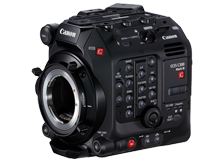
The Canon EOS C300 Mark III is the best value underwater cinema camera. It features a true super 35 dual gain output (DGO) sensor. This means that it can reduce noise at a higher ISO threashold - esentilly producing two native ISOs. It's an especially useful feature for filming in the low light conditions we see underwater. The C300 Mark III records in 4K/120p without overheating. Shooting at this high frame rate is esentially for any filmmakers who need to stabilize their underwater footage - especially when it's combined with 5 axis electronic image stabilization. Finally, the C300 Mark III is perfect for underwater broadcasting application as it has a 12G-SDI port that is compatible with long SDI cables for topside monitors or teradek units.
Key Features:
- 9.6 Megapixel Super 35 Dual Gain Output (DGO) Sensor, DIGIC DV 7 Processor
- 4K 120fps, 2K 180fps
- Dual Pixel CMOS Autofocus
- 16 Stops of Dynamic Range
- Internal Canon RAW Light (12-bit or 10-bit) and XF-AVC (10-bit) Recording
- Canon Log 2 and Log 3 Gamma
- 2x CFexpress Type B Card Slots
- 5-axis Electronic Image Stabilization
- 1x BNC (12G-SDI) Output
Underwater Housing Options:
Best Action Camera - GoPro Hero9 Black
Read our Review for the GoPro Hero8 Black Camera
The GoPro Hero9 Black just might be the best underwater action camera currently available for underwater video. While it doesn't replace a dedicated underwater video camera, it is an excellent option for scuba divers and content creators who need an ultra-small, compact camera to capture video on the go in the toughest environmental conditions. This year, improvements to the new GoPro are all very exciting for underwater shooters. The GoPro Hero9 features many positive updates from the GoPro Hero8 including an updated higher resolution 5K sensor, more effective HyperSmooth 3.0 stabilization, a new detachable lens, 8X slo mo, TimeWarp 3.0, and 30% more battery life.
Key Features:
- Ergonomic - Easy to operate
- Front & Back Touchscreen Display
- Expandable Mods System
- 5k video at 30 FPS - great for slow motion playback
- Hypersmooth 3.0 Stabilization
- Horizon Leveling
- Removable battery - 1720mAH lithium-ion
- WiFi capabilities
- Low price point for camera and housing - $450
- Water resistant to 30 feet without housing; with housing (only $50) - rated to 196 feet
Recommended Accessories:
- PolarPro Divemaster Filter Kit for Hero9 Black Protective Housing
- Polar Pro Shutter Collection for Hero9 Black
Best Smartphone for Video - Google Pixel 5
The Google Pixel 5 is our favorite smartphone for underwater video. It features two cameras - a primary 12.2 MP 1/2.55" sensor and a wide 16 MP, 107 degree FOV sensor. It can film 4K video up to 60 fps which is great for slowing down your underwater video and stabilizing it. When you pair the Google Pixel 5 with an underwater smartphone housing, you'll be able to send and post video to social media as soon as you get out of the water!
Underwater Housing Options:


